
Penstemon barbatus, known by the common names golden-beard penstemon, and beardlip penstemon, is a flowering plant native to the western United States.

Penstemon anguineus is a species of penstemon known by the common name Siskiyou penstemon. It is native to the mountains of southern Oregon and northern California, where it grows in coniferous forests, often in open areas left by logging operations.

Penstemon barnebyi is a species of penstemon known by the common names White River Valley beardtongue and Barneby's beardtongue. It is native to the mountain and basin territory of central western Nevada, where it grows in sagebrush and woodland; there is also one occurrence just over the California border.
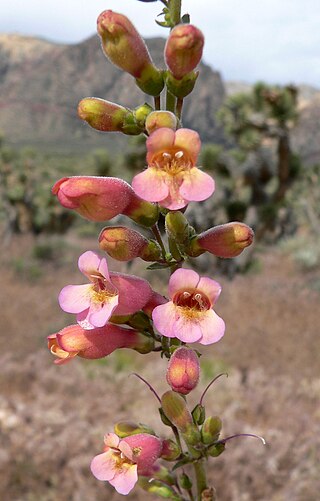
Penstemon bicolor is a species of penstemon known by the common name pinto penstemon. It is native to the desert mountains and valleys of southern Nevada, eastern California, and western Arizona, where it grows in scrub, woodland, and other local habitat. It is a perennial herb which may exceed one meter in maximum height.

Penstemon caesius, commonly known as the San Bernardino penstemon, is a low growing species of flowering plant. It is endemic to California, where it is known from the San Bernardino and San Gabriel Mountains, as well as the southern mountains of the Sierra Nevada. It is a member of the flora on rocky slopes and in coniferous forests and alpine habitat in the mountains.

Penstemon calcareus is a species of penstemon known by the common name limestone penstemon. It is native to California, where it is known from the deserts of central San Bernardino County, as well as the Death Valley area, where its distribution extends just over the border into Nevada. It grows in scrub and woodland, often on limestone substrates.

Penstemon centranthifolius is a species of penstemon known by the common name scarlet bugler. It is native to California and parts of Mexico, where it grows in many types of dry habitat from coast to desert, such as chaparral and oak woodland.

Penstemon cinicola is a species of penstemon known by the common name ash penstemon. It is native to northeastern California and southern Oregon, where it grows in forests and plateau habitat.
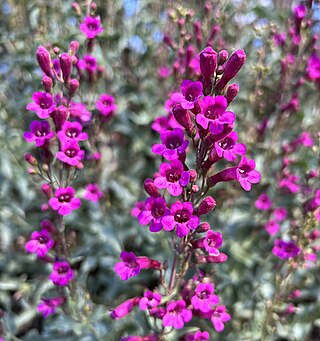
Penstemon clevelandii is a species of penstemon known by the common name Cleveland penstemon. It is native to southern California and Baja California, where it grows in mountain and desert habitat such as scrub, woodland, and chaparral.

Penstemon speciosus is a species of penstemon known by the common name royal penstemon of western North America.
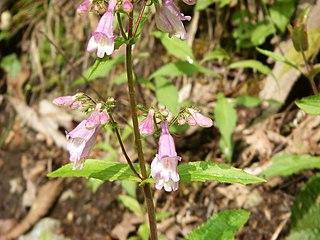
Penstemon canescens is a species of penstemon in the family Plantaginaceae. P. canescens is known by the common names gray beardtongue or Appalachian beardtongue. It is native to woodlands, forest edges, and roadsides of the southeastern United States and flowers May through July. It is a perennial herb producing stems reaching 80 centimeters in maximum height.

Penstemon angustifolius is a perennial semi-evergreen forb belonging to the plantain family. This species is 1 out of roughly 273 species of Penstemon. This species is also known as broadbeard beardtongue. This forb is native to central United States and can be noticed by its brightly and highly variable colored flowers.

Penstemon cyaneus is a species of flowering plant in the plantain family known by the common names blue penstemon and dark blue penstemon. It is native to the western United States, where it is widespread in Idaho and also found in parts of Montana and Wyoming.

The flora of the U.S. Sierra Nevada alpine zone is characterized by small, low growing, cushion and mat forming plants that can survive the harsh conditions in the high-altitude alpine zone above the timber line. These flora often occur in alpine fell-fields. The Sierra Nevada alpine zone lacks a dominant plant species that characterizes it, so may or may not be called a vegetation type. But it is found above the subalpine forest, which is the highest in a succession of recognized vegetation types at increasing elevations.

Penstemon comarrhenus is a perennial plant in the plantain family (Plantaginaceae) found in the Colorado Plateau and Canyonlands region of the southwestern United States.
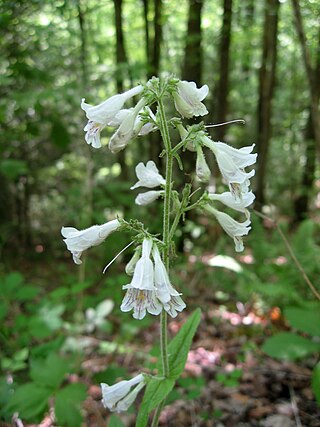
Penstemon brevisepalus, commonly known as short-sepaled beardtongue, is an herbaceous plant in the plantain family. It is a perennial that produces pale lavender flowers in late spring.
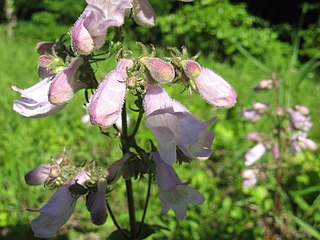
Penstemon calycosus, commonly called long-sepal beardtongue, is a species of plant in the plantain family (Plantaginaceae). It is native to eastern North America, where it native to the Upper South and Midwestern United States. It expanded its range into the northeast United States in the early 20th century. Its natural habitat is in open woodlands, prairies, and bluffs, often over limestone.

Penstemon australis is a perennial plant native to the southeastern United States, with the common name Eustis Lake penstemon.

Penstemon watsonii is a flowering plant that grows largely in Nevada, Utah, and Colorado. It grows in dry rocky areas and has blue to violet flowers.

Penstemon crandallii, also known as Crandall's penstemon, is a species of penstemon that grows in western Colorado and small parts of New Mexico and Utah. It is a low growing plant with blue to purple flowers.





















